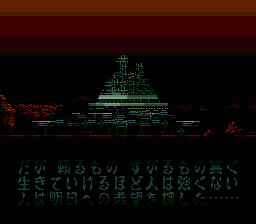Overview
 Title screen.
Title screen.Shin Megami Tensei II is an RPG released for the Super Famicom by Atlus in 1994. Like its predecessor Shin Megami Tensei, Shin Megami Tensei II is notable for using a first-person perspective in and out of battle and for the darker themes that make up its plot in comparison to its contemporaries.
It was also released on the PlayStation and Game Boy Advance in Japan. It also saw several Japan-only rereleases for iOS and both the Wii's and Wii U's Virtual Console.
Plot
 Cutscene.
Cutscene.Following the first game, the sequel presumes a world where the original game's protagonist took a Neutral alignment and founded a Utopian society whose citizens were free to follow whatever beliefs they chose. Peace lasted for about forty years before a Lawful sect called the Messians seized power and went to war against the Chaos-loving Gaeans. Shortly after, the world was reduced to a barely-habitable post-apocalyptic nightmare. The new protagonist is from one of the few habitable areas left in Japan, called Valhalla, which is part of a larger Messian-controlled community called Tokyo Millennium. When players meet him, he is a struggling gladiator nicknamed Hawk who is suffering from amnesia. Much of the early game's story line is about the slow revelation of Hawk's true memories and identity.
Gameplay
 Battle.
Battle.Similar to SMT's protagonist, Hawk receives the ability to communicate and summon demons in almost the same way, through a computer demon summoning computer called the COMP. The alignment system basically functions like in the first game, but will cause more dramatic variations in the storyline and have a deeper effect on gameplay. The combat system is expanded to include a wider variety of demons and the ability to fuse both demons and weapons together. There's also a more forgiving level of difficulty compared to the first game.
Demon Compendium
Demons are listed by race and level, from highest to lowest. Alignments are listed in parentheses: (Light/Neutral/Dark) - (Law/Neutral/Chaos). Bosses are listed by order of appearance, with their races noted in parentheses.
Herald (L-L) | Amatsu (L-L) | Avian (L-L) | Megami (L-N) |
Deity (L-N) | Avatar (L-N) | Holy (L-N) | Prime (L-N) |
Fury (L-C) | Dragon (L-C) | Lady (L-C) | Kunitsu (L-C) |
Divine (N-L) | Flight (N-L) | Mesian (N-L)- 51 Adept
- 40 Terminator
- 34 Zelator
- 26 Temple Knight
- 21 Executor
- 15 Neophyte
- 9 Butcher
| Snake (N-N) |
Yoma (N-N) | Beast (N-N) | Night (N-N) | Jirae (N-N) |
Fairy (N-N) | Demonoid (N-N)- 16 Frankie
- 11 Demi-Nandi
- 7 Heracles
- 6 Slave
- 3 Oracle
- 2 Spartan
| Fallen (N-C) | Brute (N-C) |
Femme (N-C) | Gaian (N-C)- 39 Kamen Hijiri
- 30 Ashura
- 22 Onmyouji
- 15 Jiraiya
- 8 Kugutsuchi
| Vile (D-L) | Raptor (D-L) |
Mech (D-L)- 37 Medusa
- 30 Rabbi
- 26 Golem
- 21 Junk
- 8 Iron Maiden
- 5 Crazy Dummy
| Vaccine (D-L) | Jaki (D-N) | Wilder (D-N) |
Wood (D-N) | Dead (D-N) | Tyrant (D-C) | Drake (D-C) |
Haunt (D-C) | Spirit (D-C) | Foul (D-C) | Virus (D-C)- 20 Andromeda
- 8 Spider
- 3 Moebius
|
Boss 1 | Boss 2 | Boss 3 | Boss 4 |
Fiend | Story Demons |
Pop Culture References
While the Shin Megami Tensei series' demon rosters are almost always exclusively populated by gods and entities of religion and folklore, a few of Shin Megami Tensei II's demons are culled from pop culture works that were popular prior to the game's creation.
- Betelgeuse: The bio-exorcist title character of the homophonic 1988 Tim Burton film, played by actor Michael Keaton. In Shin Megami Tensei II, he has a polka-dotted suit instead of the pinstripe one he wears in the film, and wears a bat mask and bat necklace in reference to Keaton's subsequent role as Batman in the eponymous 1989 box office hit. Betelgeuse also appears as a boss early on in the game, in a large, dragon-like form roughly reminiscent of his snake transformation seen in the movie.
- Audrey: The carnivorous talking plant of 1960's Little Shop of Horrors and its 1986 remake.
- Chris the Car: A take on Christine, the sentient car from Stephen King's 1983 novel and subsequent film.
- Ghost Q: An adaptation of Q-taro, a mischievous ghost from a Japanese manga and anime series called Obake no Q-taro.
- Messian Terminator: The design of the "Messian Terminator" is based on the appearance of the T-800 model appearing in the 1984 release of The Terminator.
Shin Megami Tensei II also marks the first appearance of Hell Biker, who is unmistakably similar to the Marvel comics character Ghost Rider.
English Translation
Like with the first Shin Megami Tensei, there is a translation patch available on Aeon Genesis. It was made available on May 13th 2004.
Log in to comment